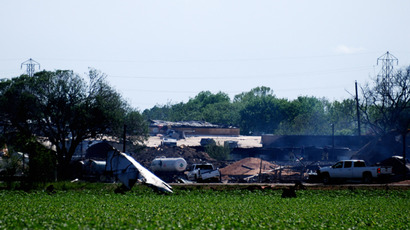West, Texas fertilizer plant fire was intentionally set; ATF offers $50k reward

The devastating fire at a fertilizer plant in West, Texas that killed 15 and injured more than 300 people was intentionally set, federal authorities have announced. The massive explosion also destroyed 500 homes and released toxic fumes into the area.
On the evening of April 17, 2013, a fire was reported at the West Fertilizer Company facility. About 22 minutes later, an explosion occurred, sending a fireball nearly 100 feet (30 m) into the air. Of the 15 people who died in the fire, 12 were first responders ‒ nearly a third of the town’s volunteer firefighting force, NPR reported at the time.
The US Geological Survey registered the explosion as a 2.1 magnitude quake, adding that “the magnitude measures only the ground motion, not the air wave, so is substantially less than the true size of the event.” It also caused a massive power outage in the surrounding neighborhood, demolished more than 500 homes ‒ as well as a high school, middle school, apartment complex and a nursing home ‒ and left a crater 93 feet (28 m) wide and 12 feet (3.6 m) deep.
After more than 400 interviews, a systematic fire-scene examination, the review of witness photos, videos and observations, as well as extensive scientific testing, the US Bureau of Alcohol, Tobacco, Firearms and Explosives (ATF) announced Wednesday that the fire has been ruled “incendiary,” meaning that it had been intentionally set.
“We have eliminated all reasonable accidental and natural causes and after the extensive testing that we conducted,” ATF Houston Special Agent in Charge Robert Elder said at a press conference. "Why the fire was set I don't know. I can't say what their intent was."
So far, the investigation has cost $2 million. On top of that, the ATF is offering a $50,000 reward “for information leading to the arrest of the person or persons responsible for the fire and subsequent explosion,” the bureau said.
The plant had been a repeated target of theft, most notably by people involved in the methamphetamine trade. The facility was the subject of 11 burglary reports and at least five ammonia leaks in the twelve years preceding the fire, according to police records. In 2002, a plant manager reported that burglars were stealing four to five gallons of anhydrous ammonia ‒ a potentially explosive liquid gas that can be used to produce meth ‒ every three days.
“The perimeter was not fenced, and the facility had no burglar alarms or security guards," McLennan County Chief Deputy Sheriff Matt Cawthon said at the beginning of the investigation into the fire. "It was a hometown-like situation. Everybody trusts everybody."
The fire and subsequent explosion cost more than $100 million in damage, but the facility only had $1 million in liability coverage “with no excess or umbrella coverage,” an attorney for West Fertilizer Company’s insurance company said in May 2013.
A lawyer representing a number of people suing the plant for losses wasn’t surprised.
"It's rare for Texas to require insurance for any kind of hazardous activity,” Randy C. Roberts said. “We have very little oversight of hazardous activities and even less regulation.”
"The bottom line is, this lack of insurance coverage is just consistent with the overall lack of responsibility we've seen from the fertilizer plant, starting from the fact that from day one they have yet to acknowledge responsibility," he added.
Authorities launched a criminal probe into the fire three weeks after the incident. The same day, a first responder was charged with felony possession of a destructive device for a pipe bomb he gave to an acquaintance sometime after the fire. The now-former West paramedic, Bryce Reed, was sentenced to 21 months in prison for that device, but he is not considered a suspect in the fire, Elder said.
In the months after the West fire, five similar plants in Texas turned away state fire marshal inspectors because there is no state fire code, and fire marshals have no ability to force inspections.
Along with lawsuits filed by those who lost relatives or homes against West Fertilizer, the town itself also sued Adair Grain Inc., the owner of the plant, as well as CF Industries, the chemical company that supplied two 100-ton shipments of ammonium nitrate in the weeks before the deadly blast.
The lawsuit claimed that 30 tons from the first 100-ton shipment of ammonium nitrate had not yet been sold and were being dangerously stored in the plant at the time of the explosion. The city also accused the supplier of failing to properly inspect the fertilizer mixing facility to determine whether hazard mitigation was necessary or to provide recommendations for safe storage. Even though the Illinois-based CF industries knew that the plant was located within a community of homes, parks and schools, it chose to blindly sell hundreds of tons of the hazardous material to the facility, the suit stated.













